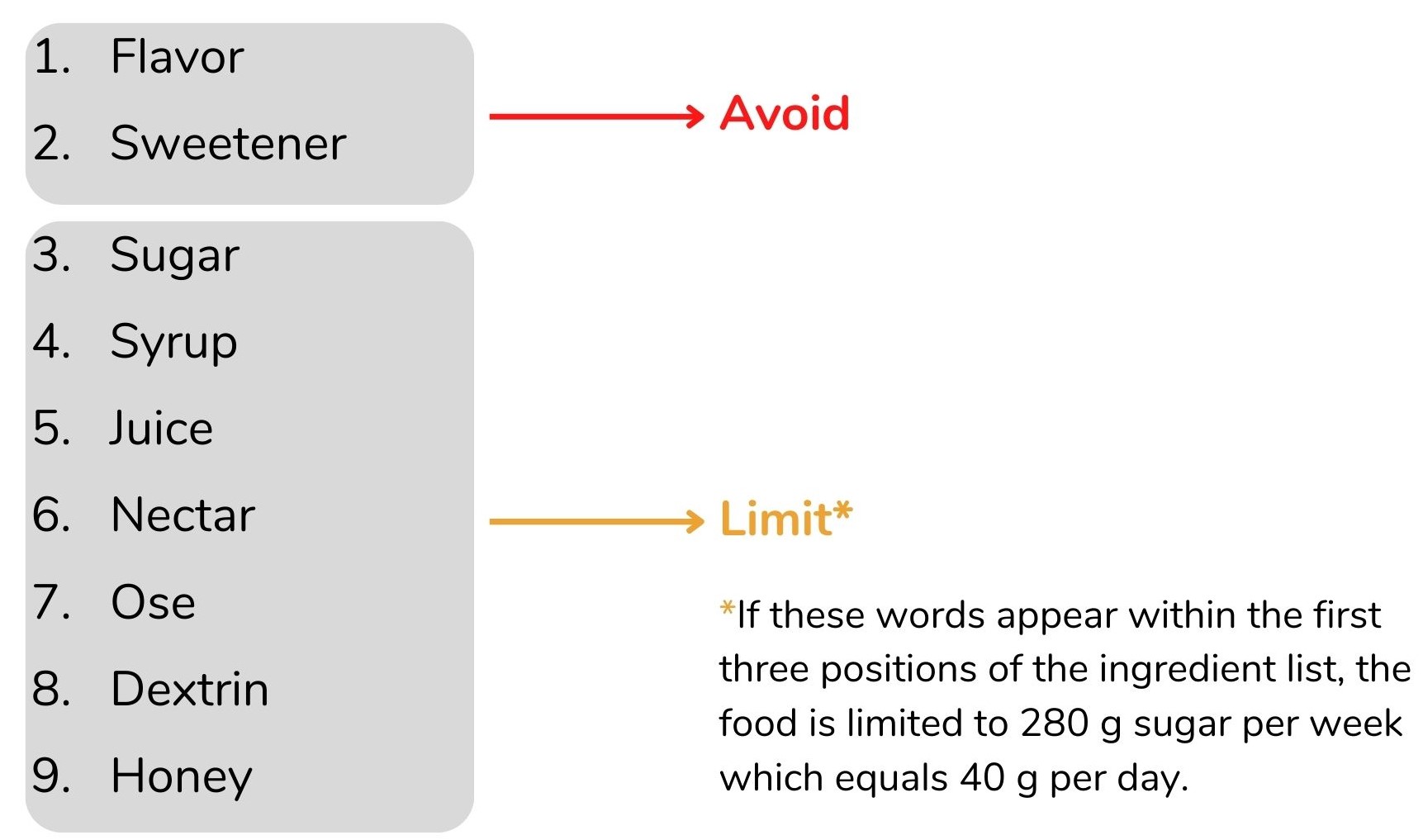The Neatic principles
Find out how you can implement Neatic in your everyday life following three simple principles.

Major points:
- Neatic pays attention to three ingredients that have become increasingly common in the food industry over the last 100 years and which cause obesity: flavors, sweeteners, and sugar.
- In Neatic, it’s enough to take a look at your food’s ingredient list and apply three simple principles.
Principle 1 - Avoid flavors
Flavors tempt you to overeat because they make food super tasty and uncouple the taste from the actual nutrient composition. If you want to learn why flavors are not good for your weight, click here.
Flavors are very easy to find on the ingredient list of foods by the word: “flavor”. They can also appear as word components, e.g. as in “strawberry flavor”, “natural flavors”, and “smoke flavoring”.
How many flavors can you eat in Neatic? The simple answer: as few as possible.
Principle No. 1:
If the term “flavor” is found on the ingredient list, avoid these foods.
In the beginning, it takes extra effort to check the ingredient lists of your favorite products. However, with time you will find new favorite products without flavors. For most foods, there are flavor-free alternatives that are not necessarily more expensive!
Applying Principle 1 can be difficult at first. You miss the super delicious foods with added flavors and have difficulties getting used to foods without them. But don’t worry: your natural sense of taste will return and soon your food will taste just as good as before. Only without flavors.
Principle 2 - Avoid sweeteners
Sweeteners lead to overeating because they add a delicious sweetness to foods, disconnect sweet taste from calorie intake and alter the gut microbiome. If you want to know why sweeteners are not good for your weight, click here.
Sweeteners are very easy to find on the ingredient list of foods by the word: “sweetener”.
How many sweeteners can you eat with Neatic? The simple answer: as few as possible.
Principle No. 2:
If the term “sweetener” is found on the ingredient list, avoid these foods.
Applying Principle 2 can be difficult at first. Your craving for sweets may seem insatiable. But with time, you will get used to foods tasting less sweet.
Principle 3 - Limit sugar
Neatic uses the term sugar to cover all monosaccharides and disaccharides that are added to foods during production. Foods sweetened with sugar make you eat more because they taste so good. With drinks in particular, the body cannot easily recognize how many calories they contain. If you want to find out why sugar is not good for your weight, click here.
Sugar is often hidden behind other terms that are not always immediately recognizable as sugar. You can recognize sugar by the following sugar signal words on the ingredient list:
- sugar such as cane sugar, grape sugar, invert sugar
- syrup such as glucose syrup, glucose-fructose syrup, sugar beet syrup
- juice such as fruit juice, apple juice, pear juice
- nectar such as coconut blossom nectar
- -ose such as glucose, fructose, sucrose
- dextrin such as maltodextrin, wheat dextrin
- honey such as blossom honey, acacia honey
How much sugar can you eat in Neatic? The simple answer: as little as possible.
However, Neatic is realistic. Limiting sugar too much is usually not feasible in the long term. Therefore, unlike flavors and sweeteners, sugar is not completely avoided, but merely limited.
Principle No. 3:
Limit sugar to 280 g per week, which is an average of 40 g per day. Only sugars that appear in the first three positions of the ingredient list are taken into account.
Principle 3 is the most difficult to implement since a few things have to be kept in mind: With this principle, Neatic focuses on products that are particularly high in sugar. Therefore, only sugars that appear in the first three positions of the ingredient list are taken into account. The higher an ingredient appears on the ingredient list, the higher its proportion in the entire product.
If no sugar signal word appears in the first three positions of the ingredients list, this food is not restricted in Neatic. Why? So that Neatic does not become unnecessarily complicated. Many foods have sugar signal words after the third position of the ingredient list. These sugars are only present in small quantities in the food.
Neatic allows the consumption of complex carbohydrates in cereals (e.g. wheat, spelt, rye, barley, oats, rice, maize, millet), pulses (e.g. beans, peas, peanuts, lentils), and potatoes without restrictions. The consumption of bread, rolls, pasta, and mashed potatoes is also not limited in Neatic.
The consumption of fruit is possible without restrictions as long as it is eaten in its edible entirety. By “edible entirety” Neatic means that all edible components are eaten completely, e.g. an apple with the peel or eating an orange whole instead of squeezing it.
Dried fruit can also be eaten in Neatic without restrictions, as long as no sugar has been added during the processing.
Homemade smoothies can be consumed as long as all edible components of the fruit have been processed.
But remember: All industrially produced fruit juices and smoothies, as well as all homemade juices, are counted as sugar in Neatic, as the whole fruit is not used.
Neatic principles in a nutshell

Why does Neatic focus on flavors, sweeteners, and sugar?
If you want to know more about the reasons why Neatic avoids flavors and sweeteners and limits sugar, click on the links for more information about these ingredients and their link to obesity.
How can you get started?
You can find five useful tips to get started with Neatic here.
